what to look for in each lead ecg
The ECG is one of the most useful investigations in medicine. Electrodes attached to the breast and/or limbs tape small voltage changes as potential divergence, which is transposed into a visual tracing
Basic landmarks
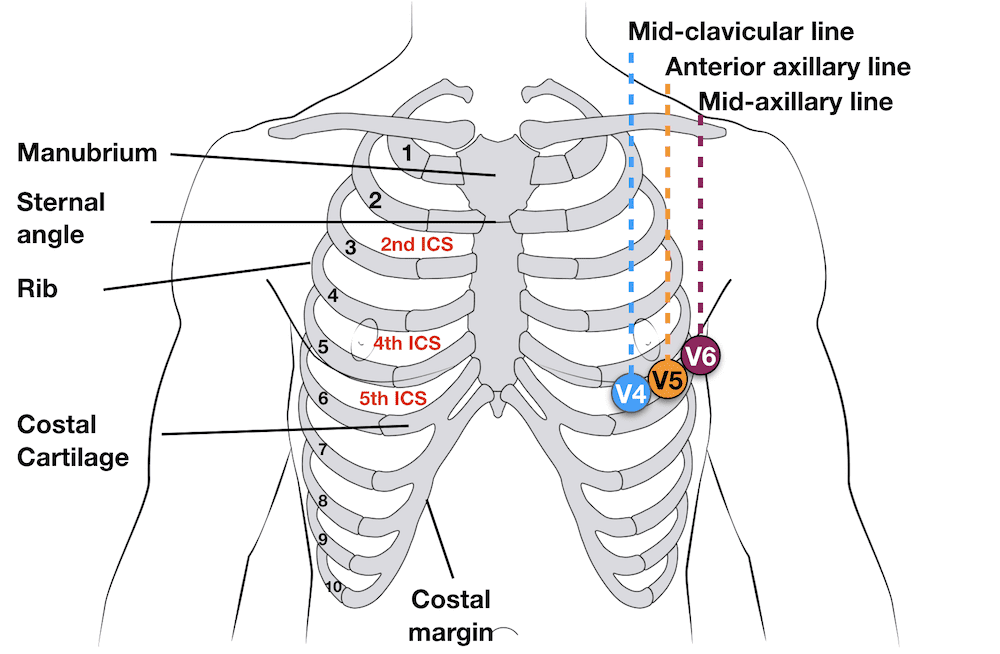
iii-electrode organisation
- Uses3 electrodes (RA, LA and LL)
- Monitor displays the bipolar leads (I, II and Iii)
- To get best results – Identify electrodes on the chest wall equidistant from the heart (rather than the specific limbs)

v-electrode organisation
- Uses5 electrodes (RA, RL, LA, LL and Chest)
- Monitor displays the bipolar leads (I, II and 3)
- AND a unmarried unipolar lead (depending on position of the chocolate-brown chest atomic number 82 (positions V1–6))
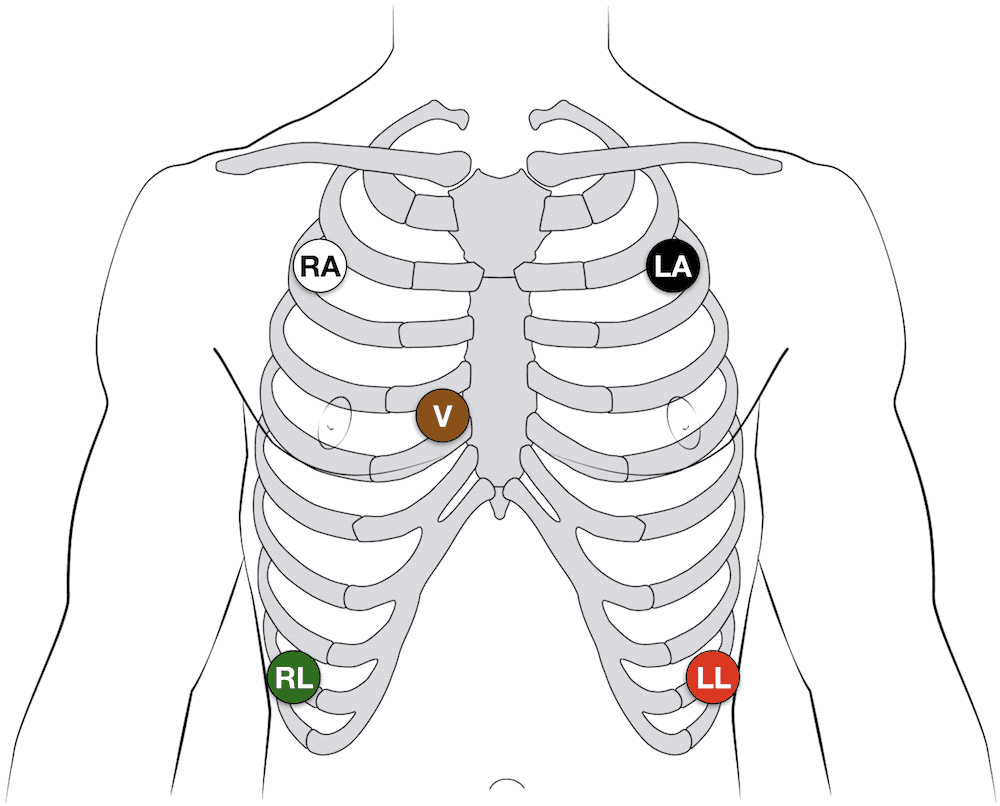
12-lead ECG
- 10 electrodes required to produce 12-atomic number 82 ECG
- 4 Electrodes on all 4 limbs (RA, LL, LA, RL)6 Electrodes on precordium (V1–vi)
- Monitors 12 leads (V1–6), (I, II, III) and (aVR, aVF, aVL)
- Allows estimation of specific areas of the heart
- Inferior (Two, 3, aVF)Lateral (I, aVL, V5, V6)Anterior (V1–4)
12-lead Precordial lead placement
- V1: 4th intercostal space (ICS), Right margin of the sternum
- V2: 4th ICS along the LEFT margin of the sternum
- V4: fifth ICS, mid-clavicular line
- V3: midway betwixt V2 and V4
- V5: 5th ICS, anterior axillary line (aforementioned level every bit V4)
- V6: 5th ICS, mid-axillary line (same level every bit V4)
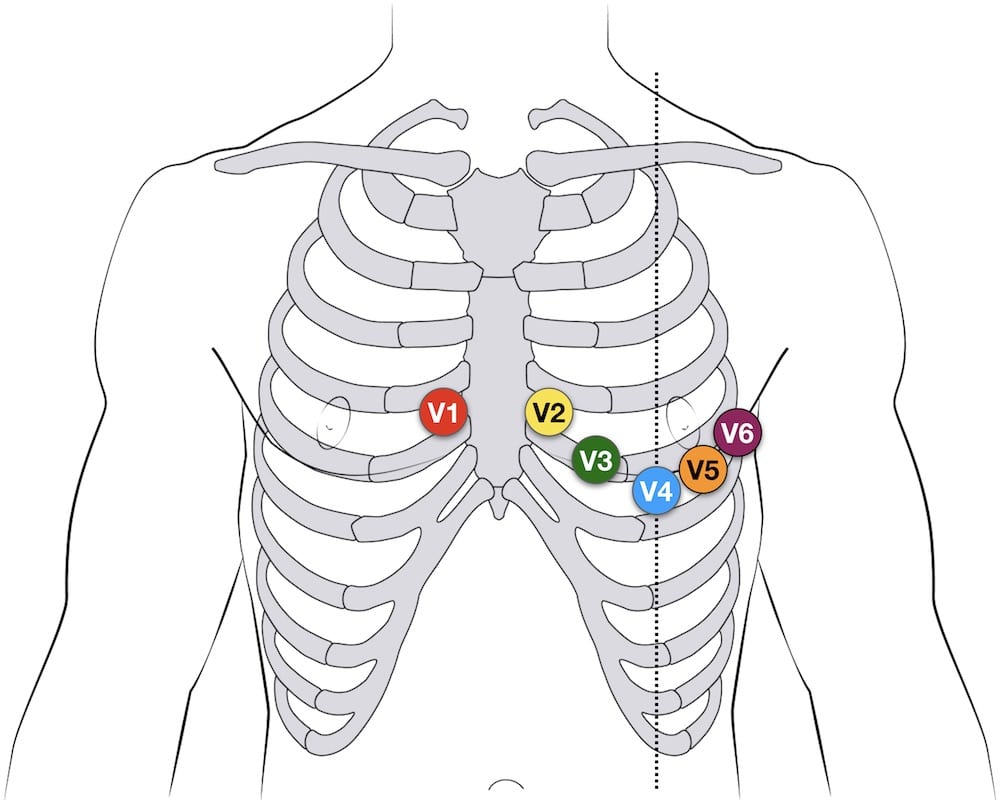
Additional Lead placements
Right sided ECG electrode placement
There are several approaches to recording a correct-sided ECG:
- A complete set of right-sided leads is obtained past placing leads V1-6 in a mirror-image position on the right side of the chest (encounter diagram, below).
- It can be simpler to leave V1 and V2 in their usual positions and only transfer leads V3-vi to the correct side of the chest (i.due east. V3R to V6R).
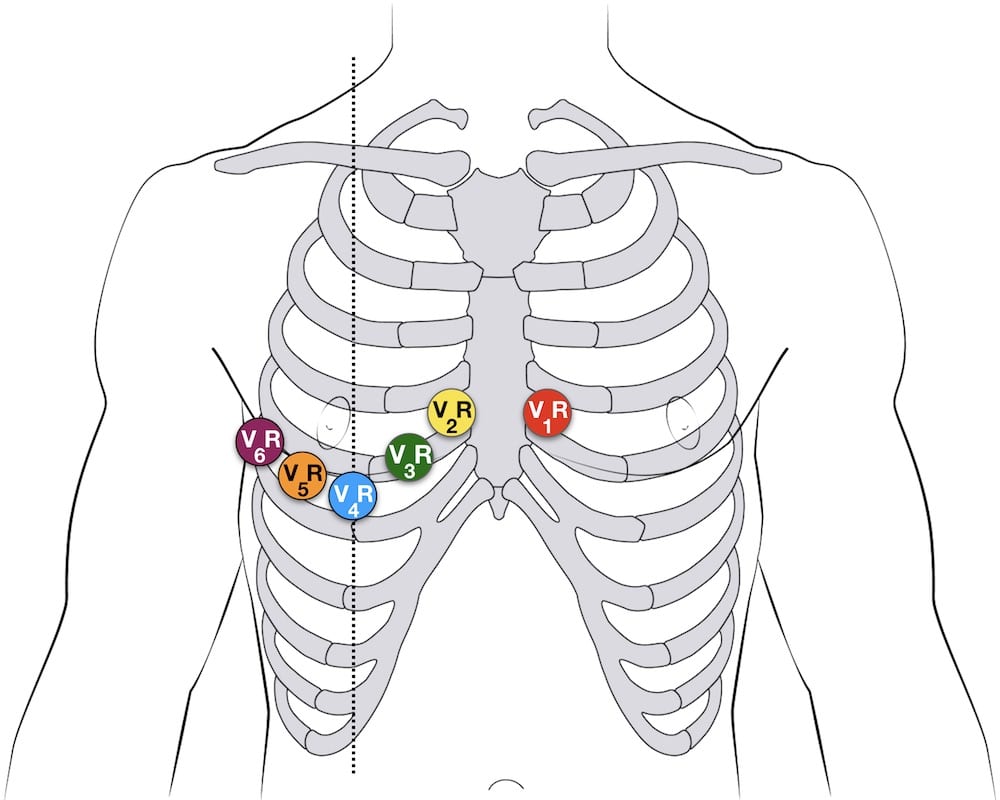
- The nigh useful pb is V4R, which is obtained by placing the V4 electrode in the 5th right intercostal space in the mid-clavicular line.
- ST elevation in V4R has a sensitivity of 88%, specificity of 78% and diagnostic accuracy of 83% in the diagnosis of RV MI. [come across Inferior STEMI]
V4R ECG lead placement
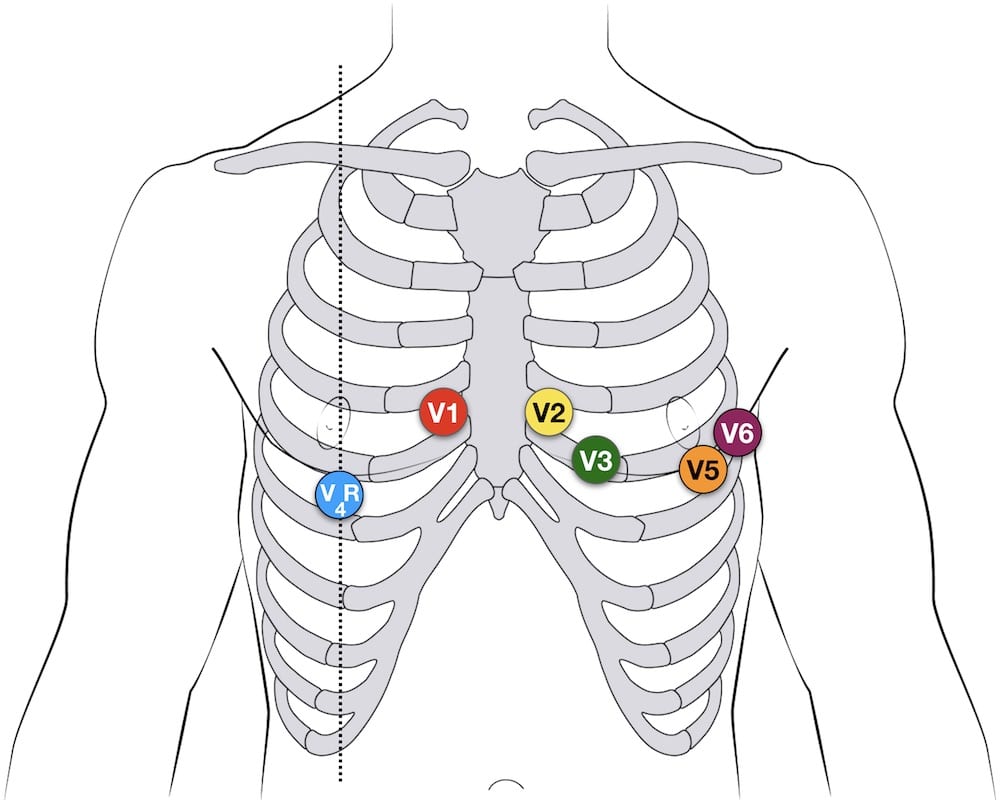
Erhardt et al first described the utilise of a right sided precordial pb (CR4R or V4R) in the diagnosis of right ventricular infarction which had previously been thought to be electrocardiographically silent. [Unmarried right-sided precordial atomic number 82 in the diagnosis of right ventricular involvement in inferior myocardial infarction. Am Center J. 1976]
Posterior leads
Leads V7-nine are placed on the posterior breast wall in the following positions:
- V7 – Left posterior axillary line, in the same horizontal plane equally V6.
- V8 – Tip of the left scapula, in the same horizontal plane as V6.
- V9 – Left paraspinal region, in the same horizontal plane as V6.
See Posterior STEMI

Lewis lead (S5-atomic number 82)
The Lewis lead configuration can assist to observe atrial activeness and its relationship to ventricular activity. Named afterwards Welsh cardiologist Sir Thomas Lewis (1881-1945) who commencement described in 1913. Useful in:
- Observing flutter waves in atrial flutter
- Detecting P waves in wide complex tachyarrhythmia to identify atrioventricular dissociation
Lewis pb placement
- Right Arm (RA) electrode on manubrium
- Left Arm (LA) electrode over 5th ICS, right sternal edge.
- Left Leg (LL) electrode over right lower costal margin.
- Monitor Pb I
Original Lewis Lead description (1913)
Thomas Lewis adult and described (1913) his pb configuration to magnify atrial oscillations present during atrial fibrillation.
When fibrillation is present and the electrodes lie in the vicinity of the correct auricle (leads 1 and 2 of the diagram) the oscillations are maximal, and in that location is but a trace of the ventricular beats. When they prevarication in the long axis of the centre (pb 3) then both the oscillations and the ventricular complexes are conspicuous. Finally, when they lie along the left or correct ventricular border (leads 4 and 5) the ventricular complexes are clear cut while the oscillations are small or absent.
The corresponding electrocardiograms are shown below the diagram, the commencement curve of which is from the customary lead II (right arm to left leg). The oscillations of fibrillation are readily identified in this fashion and their origin in the auricle is clearly indicated. In tremulous subjects, no oscillations are seen in whatsoever of the special leads.
Lewis 1913
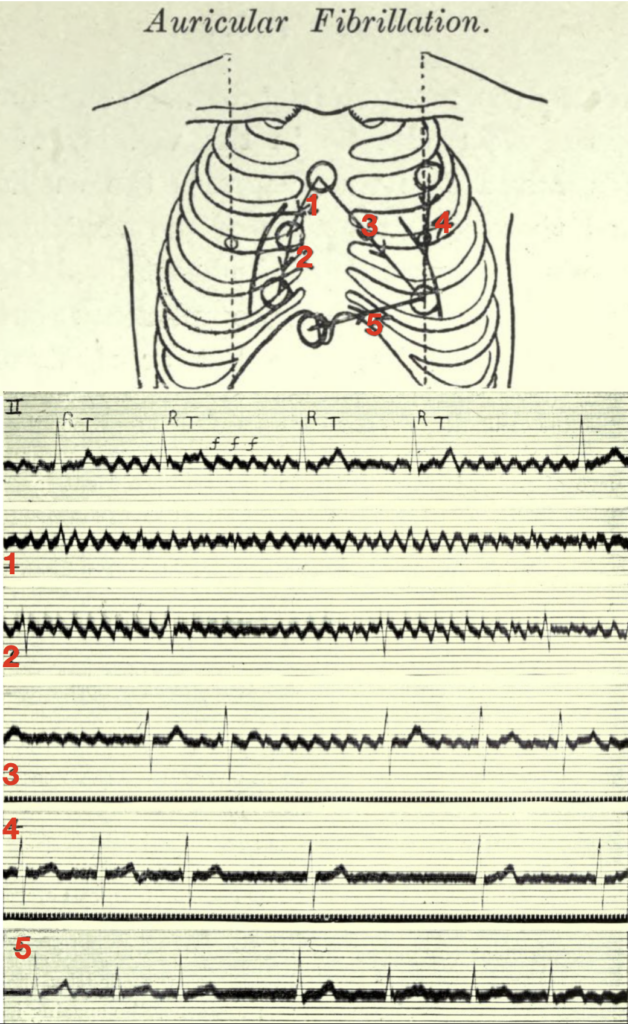
Lewis T. Auricular fibrillation 1913
The first electrocardiogram is from atomic number 82 2; it consists of irregularly placed ventricular complexes (R, T) and of large and continuous oscillations (f f).
The remaining five curves are from the chest wall.
- 1 and 2 were taken from the expanse overlying the right auricle; in these leads the oscillations are maximal and the ventricular complexes are minimal.
- 3 was taken from an oblique pb covering the whole heart, and it shows both oscillations and ventricular complexes.
- four and 5 were taken from leads along the margins of the ventricles; they show but trivial sign of the oscillations.
Fontaine leads
Fontaine bipolar precordial leads (F-ECG) are used to increase the sensitivity of epsilon moving ridge detection. Named afterwards French cardiologist and electrophysiolgist Guy Hugues Fontaine (1936-2018). Leads are placed as shown:
- Right Arm (RA) over the manubrium;
- Left Arm (LA) over the xiphoid procedure;
- and Left Leg (LL) in the standard V4 position (vthursday ICS MCL).
Instead of regular leads I, Two, and III in that location are now three bipolar chest leads that are termed FI, FII, and FIII which tape the potentials adult in the right ventricle, from the infundibulum to the diaphragm.
The vertical bipolar lead FI, (like to aVF) magnifies the atrial potentials and can be used to record:
- epsilon waves;
- search for AV dissociation in ventricular tachycardia;
- and to written report abnormal atrial rhythms when the P waves are too small on regular leads.
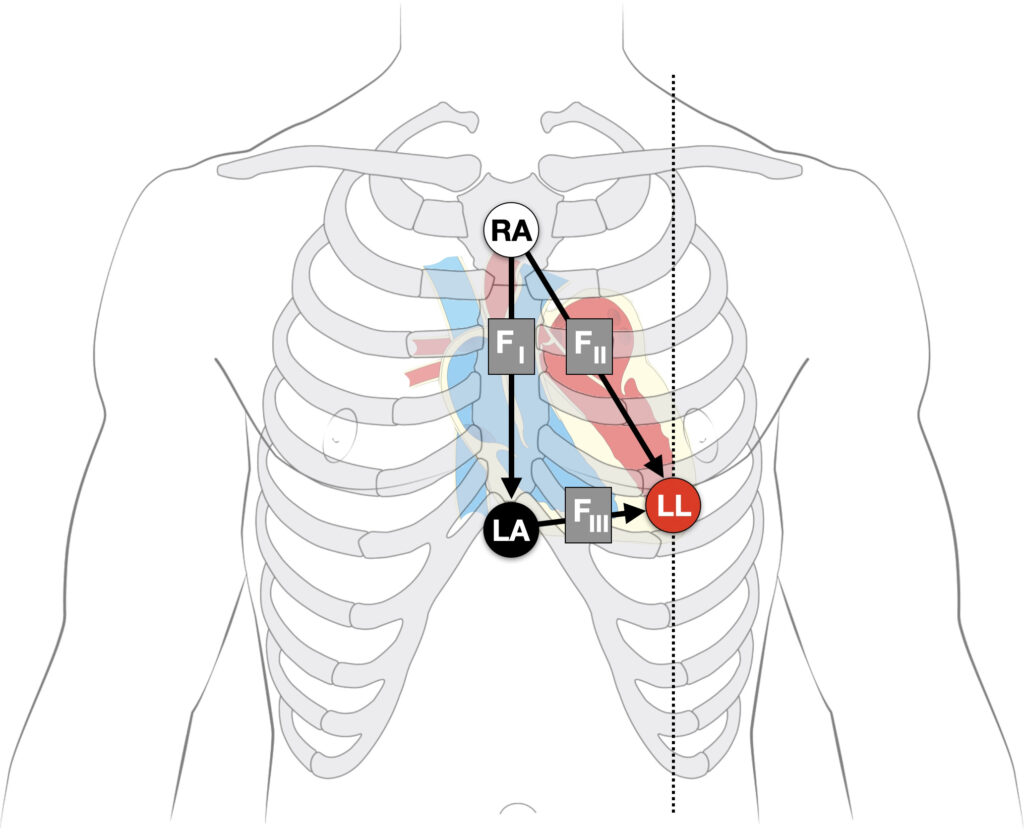
ECG Electrode Guide
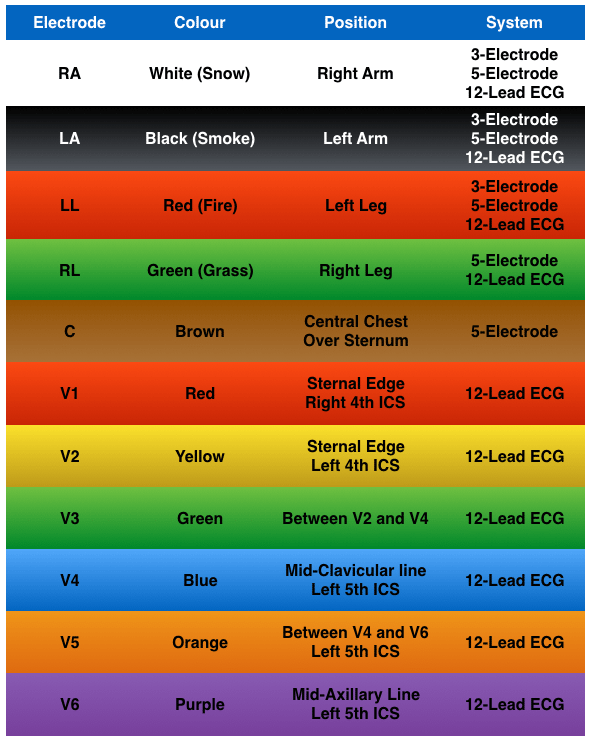
ECG Academy Videos
The ECG Lead
The Limb Leads
The Precordial Leads
Related Topics
- ECG Limb Atomic number 82 Reversals
- Upper Limb Lead reversal
Advanced Reading
Online
- Wiesbauer F, Kühn P. ECG Yellow Chugalug online course: Go an ECG expert. Medmastery
- Wiesbauer F, Kühn P. ECG Blue Belt online class: Learn to diagnose any rhythm problem. Medmastery
- Rawshani A. Clinical ECG Estimation ECG Waves
- Smith SW. Dr Smith's ECG blog.
Textbooks
- Mattu A, Tabas JA, Brady WJ. Electrocardiography in Emergency, Acute, and Critical Intendance. 2e, 2019
- Brady WJ, Lipinski MJ et al. Electrocardiogram in Clinical Medicine. 1e, 2020
- Straus DG, Schocken DD. Marriott'southward Practical Electrocardiography 13e, 2021
- Hampton J. The ECG Made Applied 7e, 2019
- Grauer Grand. ECG Pocket Encephalon (Expanded) 6e, 2014
- Brady WJ, Truwit JD. Critical Decisions in Emergency and Acute Intendance Electrocardiography 1e, 2009
- Surawicz B, Knilans T. Chou's Electrocardiography in Clinical Do: Adult and Pediatric 6e, 2008
- Mattu A, Brady W. ECG'due south for the Emergency Physician Office I 1e, 2003 and Function II
- Chan TC. ECG in Emergency Medicine and Acute Care 1e, 2004
- Smith SW. The ECG in Acute MI. 2002 [PDF]
LITFL Further Reading
- ECG Library Basics – Waves, Intervals, Segments and Clinical Interpretation
- ECG A to Z by diagnosis – ECG interpretation in clinical context
- ECG Exigency and Cardiovascular Curveball – ECG Clinical Cases
- 100 ECG Quiz – Cocky-assessment tool for examination practice
- ECG Reference SITES and BOOKS – the all-time of the remainder
ECG LIBRARY
Electrocardiogram
Mike Cadogan
Emergency physician MA (Oxon) MBChB (Edin) FACEM FFSEM with a passion for rugby; medical history; medical education; and asynchronous learning #FOAMed evangelist. Co-founder and CTO of Life in the Fast lane | Eponyms | Books | Twitter |
gabrieleformened1942.blogspot.com
Source: https://litfl.com/ecg-lead-positioning/
0 Response to "what to look for in each lead ecg"
Post a Comment